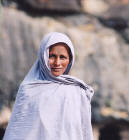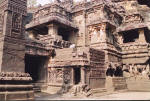 Ellora,
Maharashtra,
India
Ellora,
Maharashtra,
India
The cave temples of Ellora, a UNESCO world heritage site , are the pinnacle of Deccan rock cut architecture. Over five centuries, generations of Buddhist, Hindu and Jain monks carved chapels, monasteries, and temples from a 2 km long escarpment and decorated them with a profusion of sculptures of remarkable imagination and detail. In all there are 34 caves at Ellora: 12 Buddhist (600-800 CE), 17 Hindu (600-900 CE) and 5 Jain (800-1000 CE). Ellora represents the renaissance of Hinduism under the Chalukya and Rashtrakuta dynasties, the subsequent decline of Indian Buddhism, and a brief resurgence of Jainism under official patronage. The sculpture shows the increasing influence of Tantric elements in India's three great religions, and their coexistence at one site indicates a prolonged period of religious tolerance.
The masterpiece of Ellora is the Kailasa Temple, one of the most audacious feats of architecture ever conceived. Dedicated to Shiva, it is the world's largest monolithic sculpture, hewn from the rock by 7000 laborers over a 150 year period. Attributed to king Krishna I of the Rashtrakuta dynasty c. 760 AD, the idea was not only to build an enormous and fantastically carved representation of Mt. Kailasa, Shiva's home in the Himalaya, but to create it from a single piece of stone by first cutting three huge trenches into the rock of the Ellora cliff face and then 'releasing' the shape of the temple using hammers and chisels. Of overwhelming scale, it covers twice the area of the Parthenon in Athens, is 1-1/2 times as high, and entailed removing 200,000 tons of rock. Around the temple are a variety of dramatic and finely carved panels, depicting scenes from the Ramayana, the Mahabharata and the life of Krishna. [-- Adapted from the Lonely Planet, India, 1999]
 |
 |
 |
 |
 |
 |
||
 |
 |
||
 |
 |
 |
 |
 |
 |
||
 |
 |
||
 |
 |
 |
 |
Designed in collaboration with Vitalect, Inc. All rights reserved. |








